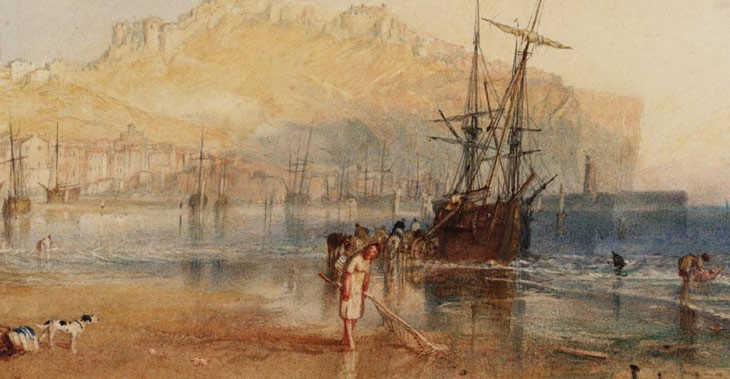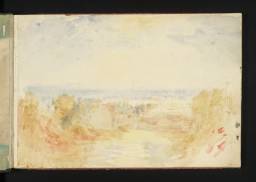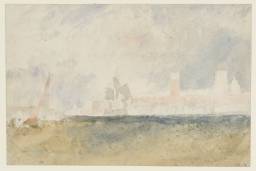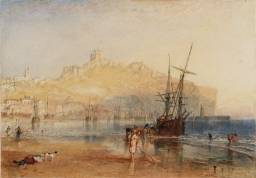From the entry
The Ports of England is a watercolour and mezzotint engraving scheme initiated by the engraver and publisher Thomas Goff Lupton (1791–1873). Lupton had made his name as the inventor of the steel-faced mezzotint engraving process, a technology which dramatically increased the durability and yield of prints of an engraved plate and which won him the Society of Artists’ ‘Isis’ medal in 1822. Turner had previously worked with Lupton in collaboration with the publisher William Bernard Cooke for the 1822–6 Rivers of England series (Tate D18134–D18141, D18144–D18149, D18151, D18155–D18156; Turner Bequest CCVIII A–H, K–P, R, V, W). In the summer of 1825 Lupton engaged Turner to produce a set of twenty-five marine watercolours depicting the ports of England. Turner’s designs were to appear in twelve parts, with two prints per part. In the end, the artist was only to produce thirteen of that projected number. Turner also ...
D17758–D17761, D17766, D18142, D18143, D18150, D18152–D18154, D25149, D25272, D25322, D25344, D25349, D25362, D25365, D25370, D25378, D25383, D25389, D25390, D25393, D25405, D25422, D25470, D40147
Turner Bequest CCIII A–D, I, CCVIII I, J, Q, S, T, U, CCLXIII 27, 150, 200, 222, 227, 240, 243, 248, 255, 260, 266, 267, 270, 282, 299, 347, 270 v
Turner Bequest CCIII A–D, I, CCVIII I, J, Q, S, T, U, CCLXIII 27, 150, 200, 222, 227, 240, 243, 248, 255, 260, 266, 267, 270, 282, 299, 347, 270 v
References
The Ports of England is a watercolour and mezzotint engraving scheme initiated by the engraver and publisher Thomas Goff Lupton (1791–1873). Lupton had made his name as the inventor of the steel-faced mezzotint engraving process, a technology which dramatically increased the durability and yield of prints of an engraved plate and which won him the Society of Artists’ ‘Isis’ medal in 1822.1 Turner had previously worked with Lupton in collaboration with the publisher William Bernard Cooke for the 1822–6 Rivers of England series (Tate D18134–D18141, D18144–D18149, D18151, D18155–D18156; Turner Bequest CCVIII A–H, K–P, R, V, W).
In the summer of 1825 Lupton engaged Turner to produce a set of twenty-five marine watercolours depicting the ports of England. Turner’s designs were to appear in twelve parts, with two prints per part.2 In the end, the artist was only to produce thirteen of that projected number. Turner also designed a vignette decoration for the publication (Fitzwilliam Museum, Cambridge)3 and three or four other finished drawings which may be connected with the scheme. Turner loaned but did not sell his designs to Lupton: the artist having done the same during his collaboration with Cooke on the Rivers series.
The first instalment of the Ports scheme appeared in May 1826. Lupton had received permission to dedicate the series to George IV and consequently, as the Turner scholar Eric Shanes writes, ‘issued a patriotically worded prospectus’ to announce it.4 The project was originally to be entitled The Harbours of England, but the name changed before the first plates were issued.5 The second and third parts of the series were published in 1827 and 1828. After the first seven designs had been reproduced (this number includes the vignette), six were returned to Turner: these are the drawings which remain in the Turner Bequest.6 In addition to this number there another six watercolours in various collections depicting the ports of Margate, Deal, Sidmouth, Falmouth, Plymouth, and Catwater at Plymouth.7
The project came into difficulty in 1828. Just as the relations between Turner and W.B. Cooke had soured and ceased in the Rivers project, so did the artist quarrel with Lupton, breaking off their collaboration as a result of disagreements over delays and faults Turner perceived in the quality of the reproductions of his designs.8 By this point Lupton was in possession of six finished plates but was still in the process of transcribing six further drawings (those now dispersed in other collections). Lupton decided to store all twelve of the mezzotint plates he had begun or completed, reprinting them under the title the Harbours of England some twenty years later in 1856.9 The art critic and life-long exponent of Turner, John Ruskin (1819–1900) provided a commentary for each plate in this revised publication, offering a critique of the composition, pictorial style, and subject matter of each work.10 As the print historians Anne Lyles and Diane Perkins write, it was through the close collaboration with Lupton that Ruskin gained a number of ‘insights into Turner’s supervision of his engravers, [Ruskin] concluding that Lupton in particular was more often “tormented than helped by Turner’s alterations”’ to proofs of each picture.11 In the end, Lupton sold the six remaining watercolour designs in his possession plus the vignette drawing ‘probably because he felt Turner owed him compensation’.12
In preparation for the Ports of England Turner appears to have reconsidered material gathered in connection with the Picturesque Views of the Southern Coast of England (1814–26) and subsequent projects.13 This was ‘not in any merely repetitive sense’, curators David Blayney-Brown and Kenneth Reedie write, rather it was a ‘synthesis of his ideas and experience of coastal life’.14
The Ports views, with the exception of Scarborough (Tate D18142; Turner Bequest CCVIII I), are taken at sea. This offers a sense of drama (the turbulent waters depicted with a characteristically accurate churn and swell) but also the opportunity to represent closely and attentively an impressive array of shipping and other vessels. Craft range from the lugsail in Whitby (Tate D18143; Turner Bequest CCVIII J); the cross-Channel steamer packet at Dover (Tate D18154; Turner Bequest CCVIII U); the brig straining at a diagonal pitch against the stormy sea at Ramsgate harbour (Tate D18150; Turner Bequest CCVIII Q); and finally the striking parade of a man-of-war, navy longboat, cutter, sheer-hulk, and collier-brig in the view of Sheerness (Tate D18153; Turner Bequest CCVIII T). This display not only makes manifest Turner’s facility in recording the structure and movement of shipping at sea but also represents the significance of the English naval fleet in the context of the nation’s trading, military, and imperial prowess.
Turner’s view of Portsmouth is where these patriotic associations are at their most conspicuous (Tate D18152; Turner Bequest CCVIII S). Turner couples a mammoth battleship in the centre of the composition with the lofty tower of the Admiralty Semaphore to its right, a strong beam of sunlight illuminating both. This building was a signalling device able to communicate with the Admiralty in London in fewer than three minutes by means of a series of intermediate relay signals.15 Turner also included a sailor in the foreground waving to the crew on the battleship in a gesture of camaraderie. In all, this is a picture of the grandeur, administrative rigour, and heroism of the English naval fleet.
Turner also makes reference to local industry and daily life in these drawings: shrimpers, crab-fishers, washerwomen, and fishing boats in Scarborough harbour; sailors hauling in fish at Whitby; and a lobster boat and hoy laden with cargo at Dover. The views also include buildings of historic and antiquarian interest: the ruined medieval fortress of Scarborough Castle, for example, the Benedictine Whitby Abbey, and the imposing twelfth-century Dover Castle.
Much like the Rivers of England designs, these watercolours are ‘concentrated in terms of size, scale, and pictorial dynamism’.16 They are relatively small in dimensions, averaging at one hundred and sixty by two hundred and thirty millimetres. The high level of finish and chromatic richness which characterise them was achieved through a stippling method: the meticulous application of pigment through very fine dots and hatching.
Related material for the finished Ports designs has been combined in this catalogue. This includes the Ports of England sketchbook and a group of loose sheets comprised of colour studies or ‘colour beginnings’ and pencil sketches.
Gillian Forrester, ‘Lupton, Thomas Goff (1791–1873)’, Oxford Dictionary of National Biography, Oxford University Press, 2004.
How to cite
Alice Rylance-Watson, ‘‘Ports of England’ Watercolours and Related Works c.1822–8’, March 2013, in David Blayney Brown (ed.), J.M.W. Turner: Sketchbooks, Drawings and Watercolours, Tate Research Publication, September 2014, https://www




